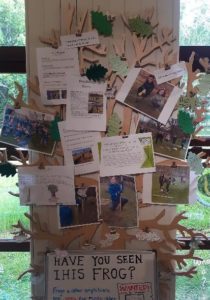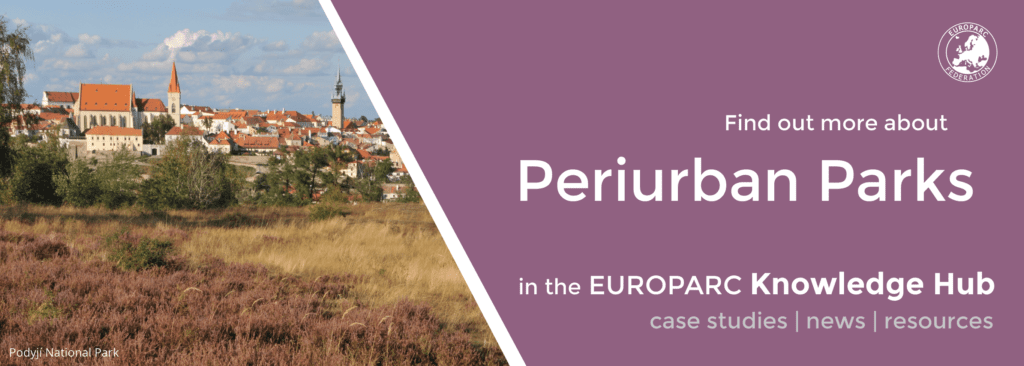Exploring how Periurban Parks engage Urban Audiences
Guided visit at Sas Hegy nature reserve, on the edge of Budapest © Matthew Ross
Every year, the Alfred Toepfer Natural Heritage Scholarship supports the work of young conservationists in Protected Areas across Europe. Matthew Ross, learning and discovery ranger at the Peak District National Park, was one of the winners of the Scholarship in 2019. He travelled to Scotland and Hungary to learn more about how two Periurban Parks are approaching visitor management and nature education. The following article is written by Matthew. You can download his full report and a special toolkit at the end of the article.
The special case of Periurban Parks
Periurban Parks are a portal to nature connection for millions of people. However, the proximity to urban areas can also bring problems, with large numbers of visitors harming fragile ecosystems. Despite these challenges, there are also wonderful opportunities: we have a huge pool of people, on our doorstep, to inspire about nature! With our help, young people in these urban areas can learn to appreciate our beautiful landscapes and aspire to conserve them.
I work in the U.K’s Peak District National Park. This beautiful area is girdled by the urban areas of Manchester, Sheffield, Derby and Stoke; the threat of urban encroachment helped us become the U.K’s first national park. Seventy years later, it is these urban areas which provide a majority of the park’s visitors: millions every year!
My work involves trying to build a deeper connection between our visitors, especially young people, and the landscape. Our team provides outdoor learning experiences for schools, families, and community groups.
I have been very privileged to benefit from an Alfred Toepfer Natural Heritage scholarship, enabling me to travel to two other European national parks close to urban areas. My study aims were:
- To investigate issues caused by large visitor numbers, and how each park is trying to tackle these through engaging visitors.
- Observing engagement techniques used by parks, with a focus on inspiring young people.
- Finding out how national parks enable self-led visitors and remove barriers for less socially mobile groups.
The two parks I chose were:
- Duna-Ipoly Nemzeti Park, close to Hungary’s capital, Budapest.
- Loch Lomond & The Trossachs National Park, just outside Glasgow, Scotland.
Engaging visitors of the Parks
In each park I met staff, visited key interpretation sites and observed education sessions and events in action. It was very instructive to find parallels between our different national parks. Despite our different contexts, many of the issues we face are similar: antisocial behaviour, wildfires, traffic congestion and impacts from outdoor pursuits. These are made more severe by the volume of visitors from urban areas.

Display celebrating young people’s conservation, Loch Lomond © Matthew Ross
All three parks recognise that direct engagement offers a way, perhaps the best way, to communicate about these issues. Education sessions can provide direct care messages to audiences about environmental issues, helping to prevent problems and inspire positive action. Beyond the immediate benefits, all three parks are “playing the long game”, trying to inspire a love of nature that will filter through generations to forge a long-lasting stewardship of these landscapes.
Young people are particularly key to this. Engaging them and providing “Eureka!” moments that connect them with nature can encourage a lifetime of learning about, and caring for, our environment.
School visits, family events and activity trails all provide great ways of enabling this. Activities that allow young people to have their own, close-up connections with nature, such as pond dipping and ‘Bio-blitzes’ are especially valuable, and all three parks make this a key feature of their work. Nature play, with mud, sticks, and water is great, too!
There are also opportunities for promoting positive action through conservation. In Loch Lomond NP, junior rangers groups run in local schools, and I observed students removing invasive species from a local nature reserve. Photos and reflections from children taking part in conservation tasks are collected and displayed in the park’s visitor centre; this creates pride in their actions and helps to inspire other visitors.
Creating easy access to the Parks
Although the urban population are very closely situated to our national parks, many of them have barriers to visiting. Traditionally, our demographics have not reflected the diverse populations of our cities, and we must try to make our parks accessible to all. Loch Lomond & The Trossachs has pioneered an Educational Travel Grant, which helps enable economically disadvantaged schools and communities.
Creating ‘National Park champions’ within local communities can help inspire people to visit, and to do so responsibly. In the Peak District, we are developing community projects and an ‘Ambassador school’ scheme to this end.
Another way of engaging harder-to-reach-groups is meeting them in their local green spaces; the best connections with nature often begin at home, and sometimes these can be useful stepping stones to visiting bigger, wilder landscapes. Duna-Ipoly has pioneered a unique way of doing this: a mobile pond-dipping laboratory that travels around different areas, connecting children with nature (and the environmental issue of water quality) close to their schools.
Accessibility and engagement possibilities for independent visitors are important too. Interpretation boards, activity trails and online resources can all help with this. Duna-Ipoly even has a National Park app.
The above is just a very brief summary of the great work being done in these national parks. Learning from their innovative, inspiring staff has been very valuable, and now I hope to build on this to help my own team engage and innovate more effectively.
I feel very grateful for this opportunity, and would recommend any young people working in protected areas to apply for an Alfred Toepfer Natural Heritage Foundation scholarship.
If you’d like to learn more about some nature connection and engagement techniques, I have put together a small ‘toolkit’ of ideas that can be downloaded here.
